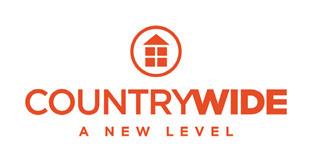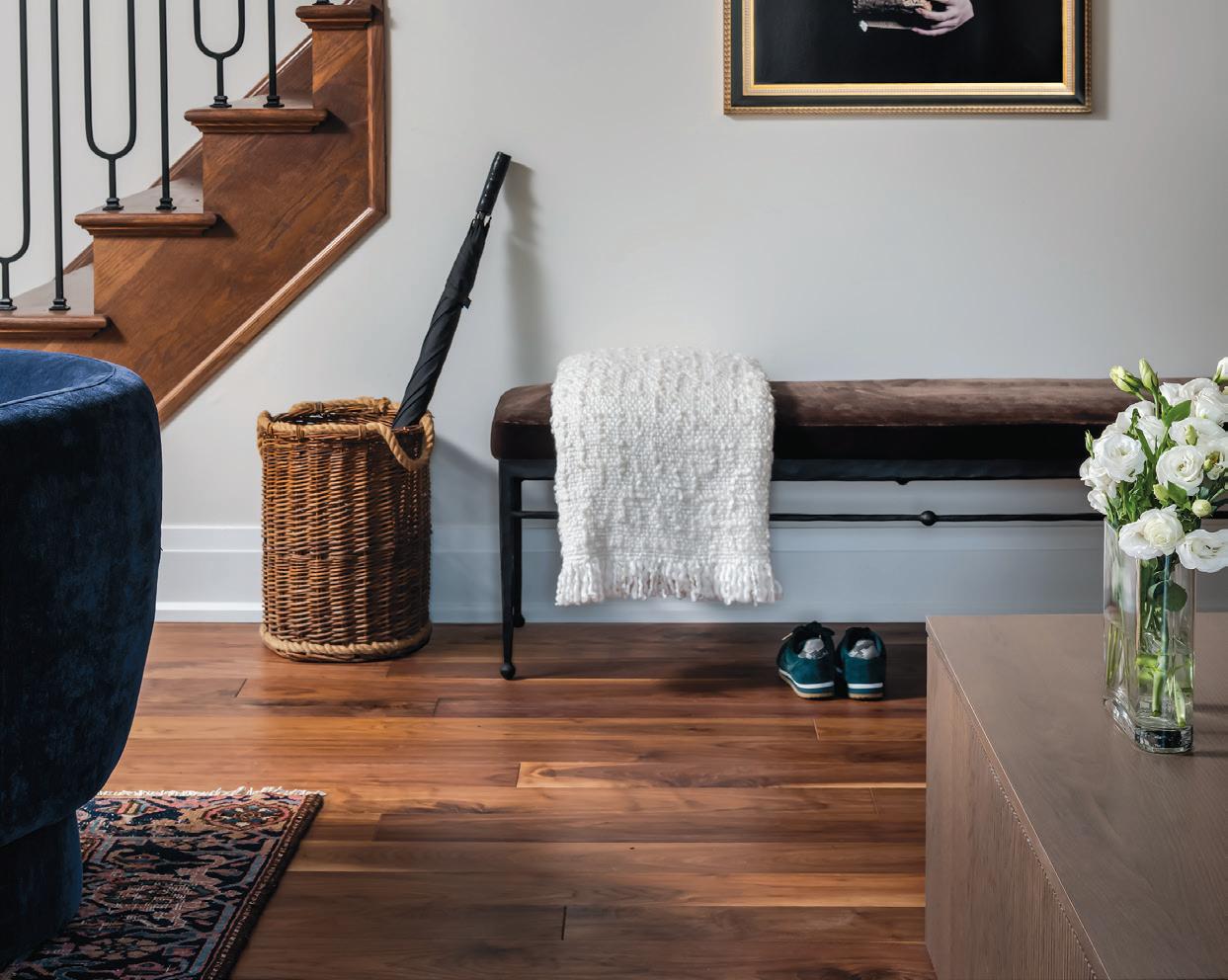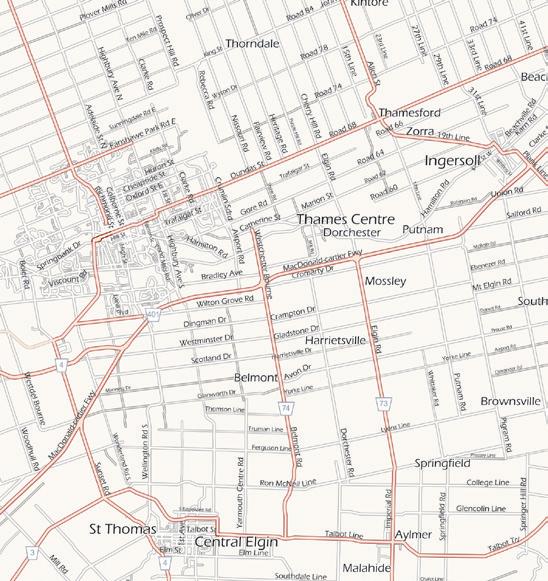




































Thank you to our many trades, suppliers and consultants who supported the 18th Annual Kylemore Kares Charity Golf Tournament. Together, we continue our commitment to give back to many charitable organizations in the community. Our sincerest appreciation for making this annual event a huge success.













































An award-winning interior designer, Mariam Aboutaam is Director, Sales and Marketing, Interior Design at Kylemore, Markham, Ont., a builder known for master-planned communities and luxury homes. kylemoreliving.com.
Jesse Abrams is Co-Founder at Homewise, a mortgage advisory and brokerage firm based in Toronto. thinkhomewise.com
Mike Collins-Williams, RPP, MCIP, is CEO West End Home Builders’ Association. westendhba.ca.
Elechia Barry-Sproule is President of the Toronto Regional Real Estate Board (TRREB) and Broker/Owner of Red Apple Real Estate Inc. She is committed to mentoring and supporting real estate professionals across the industry. trreb.ca.
Debbie Cosic is CEO and founder of In2ition Realty. She has overseen the sale of more than $15 billion worth of real estate. With Debbie at its helm, In2ition has become one of the fastest-growing and most innovative new home and condo sales companies. in2ition.ca
Barbara Lawlor is CEO of Baker Real Estate Inc. A member of the Baker team since 1993, she oversees the marketing and sales of new home and condominium developments in the GTA, Vancouver, Calgary and Montreal, and internationally in Shanghai. baker-re.com
DECOR | LINDA MAZUR
Linda Mazur is an award-winning designer and Principal of Linda Mazur Design Group. With almost two decades of experience this in demand multi-disciplinary design firm is known for creating relaxed, stylish spaces and full-scale design builds throughout the GTA and Canada. lindamazurdesign.com @LindaMazurGroup
Dave Wilkes is president and CEO of the Building Industry and Land Development Association (BILD), the voice of the home building, land development and professional renovation industry in the GTA. For the latest industry news and new home data, follow BILD on Twitter at @bildgta or visit bildgta.ca
Official Media Partners: æ Sign up to receive digital editions & newsletters to your inbox!

SENIOR VICE-PRESIDENT, SALES, NEXTHOME
Hope McLarnon 416.708.7987
hope.mclarnon@nexthome.ca
SENIOR MEDIA CONSULTANT
Amanda Bell 416.830.2911 amanda.bell@nexthome.ca
EDITORIAL DIRECTOR
Amanda Pereira
EDITOR-IN-CHIEF – GREATER TORONTO AREA
Wayne Karl wayne.karl@nexthome.ca
CONTRIBUTORS
Mariam Aboutaam, Jesse Abrams, Elechia Barry-Sproule, Mike Collins-Williams, Debbie Cosic, Barbara Lawlor, Linda Mazur, Ben Myers, Dave Wilkes
EXECUTIVE MEDIA CONSULTANTS
Jacky Hill, Michael Rosset
VICE-PRESIDENT, MARKETING – GTA
Leanne Speers
MANAGER CUSTOMER SALES/SERVICE
Marilyn Watling
SALES & MARKETING CO-ORDINATOR Gary Chilvers
BUSINESS DEVELOPMENT MANAGER Josh Rosset
DISTRIBUTION distributionteam@nexthome.ca
ACCOUNTING INQUIRIES accountingteam@nexthome.ca
DIRECTOR OF PRINT MEDIA Lauren Reid–Sachs
VICE-PRESIDENT, PRODUCTION – GTA Lisa Kelly
PRODUCTION MANAGER – GTA Yvonne Poon
GRAPHIC DESIGNER & PRE-PRESS COORDINATOR
Hannah Yarkony
Published by nexthome.ca
Advertising Call 1.866.532.2588 ext. 1 for rates and information. Fax: 1.888.861.5038
Circulation Highly targeted, free distribution network aimed at real estate buyers using street level boxes, racking and Toronto Star in-home delivery.
Canadian subscriptions 1 year = 13 issues – $70 (inc. HST). Canada Post – Canadian Publications Mail Sales Product Agreement 40065416.
Copyright 2025 All rights reserved. All copyright and other intellectual property rights in the contents hereof are the property of NextHome, and not that of the individual client. The customer has purchased the right of reproduction in NextHome and does not have the right to reproduce the ad or photo in any other place or publication without the previous written consent of NextHome.
Editorial Submissions from interested parties will be considered. Please submit to the editor at editorial@nexthome.ca.
Terms and Indemnification Advertisers and contributors: NextHome is not responsible for typographical errors, mistakes, or misprints. By approving your content and/ or submitting content for circulation, advertisers and contributors agree to indemnify and hold harmless NextHome and its parent company from any claims, liabilities, losses, and expenses (including legal fees) arising out of or in connection with the content provided, including but not limited to any claims of copyright infringement, unauthorized reproduction, or inaccuracies in the content. Advertisers acknowledge that they have the necessary rights, permissions, and licenses to provide the content for circulation, and they bear full responsibility for the content’s accuracy, legality, and compliance with applicable laws upon approval. Contributors acknowledge NextHome reserves the right to omit and modify their submissions at the publisher’s discretion.

WAYNE KARL EDITOR-IN-CHIEF HOMES Magazine
EMAIL: wayne.karl@nexthome.ca
TWITTER: @WayneKarl
When the Bank of Canada held its overnight lending rate at 2.75 per cent in April (after six consecutive reductions beginning last summer), again in June – and yet again on July 30 – many housing and economics experts raised an eyebrow. With all the uncertainty caused by the tariff discussion with the U.S. adding to the pre-existing apprehension in the real estate market, a rate drop would be more than welcomed news.
BoC thought otherwise, though, citing the need to “gain more information about both the path forward for U.S. tariffs and their impacts.”
The decision was questioned even by the Canadian Mortgage Brokers Association of Ontario (see page 8), and outright criticized by Premier Doug Ford.
We’re now seeing some of the effects of this decision. According to the latest Royal LePage House Price Survey and Market Forecast, the spring market – typically the busiest time of year for homebuying and selling – was subdued in several regions this year, namely in Toronto and Vancouver, two of the country’s largest and most expensive markets. Amid global political and economic uncertainty, homebuyers continued to take a cautious, waitand-see approach, the realty firm says.
“Homebuyers approached the start of the 2025 spring market with hesitation, dampening what is typically the busiest season on the real estate calendar,” says Phil Soper, president and CEO of Royal LePage. “With trade disputes, a federal election and international conflicts dominating headlines through the first half of the year, many prospective buyers chose to wait. Yet, market fundamentals remain sound; interest is strong while activity is subdued, reflecting the uncertainty weighing on consumer sentiment. Encouragingly, June’s robust employment report may help rebuild confidence and bring more buyers off the sidelines in the months ahead.”
There are some encouraging signs, however. “With borrowing costs stable and inventory levels continuing to build, the foundation is in place for a stronger market this fall – and signs of renewed confidence are beginning to emerge,” adds Soper.
More locally, Toronto Regional Real Estate Board Chief Information Officer Jason Mercer says, “Additional interest rate cuts would make monthly mortgage payments more comfortable for average GTA households. This could strengthen the momentum experienced over the last few months and provide some support for selling prices.”
So, can we bank on BoC implementing a much-needed rate reduction during its next announcement on Sept. 17? Perhaps we shouldn’t go that far, but all signs point to the likelihood. And with healthy longer term fundamentals remain place, we can also hope for stronger market performance beginning in the fall.

Signs of the much-anticipated spring market finally materialized in June as greater inventory and softer overall values reinvigorated buyer intentions and bolstered demand for detached housing in the Greater Toronto Area (GTA), Greater Vancouver and the Fraser Valley, according to a new report from ReMax Canada.
ReMax Canada’s 2025 Hot Pocket Communities Report examined 83 markets across the Greater Toronto Area, Greater Vancouver and the Fraser Valley, between Jan. 1 and June 30, 2025, and found that almost 23 per cent of markets reported detached housing sales on par or ahead of year-ago levels in the first half of the year, while slightly more than 19 per cent reported an upswing in values.
In terms of sales during the sixmonth period, the GTA’s 416 area code led in rebounding momentum, with 34.2 per cent of Toronto 416 neighbourhoods experiencing stable or growing activity in the detached home segment – ahead of the GTA’s more suburban 905 area code.
Limited inventory levels in key areas of Greater Vancouver and Toronto proper – especially at affordable price points – are supporting price appreciation in the detached home category.
“After a prolonged period of uncertainty, we’re starting to see slow but building momentum in Canada’s largest real estate markets,” says Don Kottick, president of ReMax Canada. “Buyers who have been sitting on the sidelines for months, prepared and ready to pounce, are finally starting to make their moves. Life moves forward and eventually, necessity dictates action. Sellers are more accommodating as well, often willing to work with buyers to achieve a sale. Timing is crucial, as buyers are well informed and markets appear to have bottomed out.”

Detached home sales in the GTA fell to 13,991 in the first half of the year, according to Toronto Regional Real Estate Board data – the lowest level on record in more than a decade and nearly 34 per cent below the 10-year average. Still, the detached category remains the frontrunner in terms of percentage of overall sales year-to-date, representing the lion’s share of activity at 45.2 per cent of total residential sales in the first six months of the year.
Growing urgency for affordable homes in Toronto was identified by ReMax Canada as a major driver in recent weeks, with many buyers in the $850,000 to $1.2 million price range worried that the window of opportunity is already starting to close.
“In fact, certain microcosms cropping up within Toronto markets – including hot pocket communities such as Leaside, East York, Riverdale, Trinity-Bellwoods, Davisville and Little Italy – are consistently experiencing healthy demand for detached homes,” says Tim Syrianos, broker at ReMax Ultimate Realty Inc. and ReMax Condos Plus. “And while many of those properties will sell in multiple offers, make no mistake – today’s buyers are laser focused on value and will walk away from properties if sellers are unreasonable.”
“Buyers are cautiously re-entering detached housing markets, taking advantage of more balanced market conditions, especially at affordable
price points,” says Tim Hill, of Tim Hill and Associates, ReMax All Points Realty. “Most are young professionals who have spent years saving for a downpayment and are wellpositioned to now move forward with their purchase plans.”
While overall housing sales in the GTA have declined compared to year-ago levels, demand for detached housing continues to bolster the market, with the segment representing nearly half of total sales. First-time buyers have been driving detached sales in recent weeks, spurred by the increase in May’s average price, with many realizing that as detached property values rise, the window of opportunity is closing.
Certain microcosms within the Toronto market – including Leaside, East York, Riverdale, TrinityBellwoods, High Park, Davisville, and Little Italy – are experiencing healthy activity in the $850,000 to $1.2 million price range, with some properties selling in multiple offers. Average days on market in the central core, for instance, was considerably less than the overall average at this price range, with most homes moving within 19 days during the first six months of the year. The market for homes priced between $1.8 million and $2.2 million is also solid across the city, particularly in established traditional neighbourhoods.
The Residential Construction Council of Ontario (RESCON) and several industry representatives recently hosted federal Housing and Infrastructure Minister Gregor Robertson and Canada’s Secretary of State for Labour John Zerucelli, to discuss challenges facing the industry.
The group toured the H+ME Technology Plant in Etobicoke, and later the minister and secretary of state met with the group to discuss the challenges facing Ontario’s residential construction sector and the potential effects on the economy. The group also had a wide-ranging conversation about initiatives that need to be put in place to spur new residential building.
Attendees discussed the need to accelerate both PropTech and ConTech, as well as the state of offsite construction and what can be done to accelerate growth and increase production and delivery of housing. RESCON says it appreciates that Robertson and Zerucelli took time out to meet and look forward to working with the federal government to spur construction of more housing.

“Immediate bold and concerted action is needed to get more shovels in the ground for housing projects,” says RESCON President Richard Lyall. “The residential construction industry is in dire

straits, and new housing starts and sales are grim. We need to lower development charges, reduce red tape which only adds to approval timelines, and speed up the approvals process. Without a healthy residential construction industry our economy will suffer.”
The association warns that a decline in residential construction has the potential to devastate Ontario’s economy. A 30-per-cent drop in industry activity, for example, could result in 121,500 total job losses; a 50-per-cent drop would result in 202,500, and an 80-per-cent dip would total 324,000.
“The entire economy of Ontario would feel the effects of such an industry employment decline,” says Lyall. “Industries that supply the new home market with everything from lumber to drywall and windows would also be affected. A decline in the construction workforce would result in hardship for many families. It is critical that we take swift action to boost homebuilding in Ontario.”

The Canadian Mortgage Brokers Association of Ontario (CMBA Ontario) questions the recent decision by the Bank of Canada to hold its policy interest rate at 2.75 per cent, saying “while we understand (BoC’s) aims in taking a cautious approach to the chaotic tariff situation with the United States, we believe that more direct action is needed to maintain consumer and investor confidence.”
CMBA Ontario says it favours a cut to the bank’s policy interest rate, which would prioritize Canadian homeowners and those looking to buy. In tandem with eliminating the GST on homes for first-time buyers, an interest rate cut would have further incentivized investment in building new housing supply, improving affordability for all Canadians.
“While we can certainly understand why the Bank of Canada wants to
take a cautious approach, we fear that holding rates steady now will do little to encourage confidence in the housing market,” says Michele Campbell, president of CMBA Ontario. “A rate cut would have been a promising signal to both prospective owners and investors, as well as easing costs for those existing homeowners with variable rate mortgages.”
While interest rates remain high, borrowing costs present an obstacle to new investments and new owners. In this way it keeps housing out of reach for many Canadians in two ways – both by reducing the rate of new supply, as well as keeping high the costs of mortgages.
CMBA Ontario says it would have supported a rate cut as a means of improving affordability.
“The reality is that holding rates stable will prevent many
Canadians from achieving their dream of home ownership,” adds Campbell. “This isn’t just a decision that only affects the present, either; maintaining the policy interest rate will delay or cancel projects, continuing high prices for Canadians into the future. If we want to realize the federal government’s strategy of making housing more affordable, we need to improve investor and consumer confidence in the housing market. A rate cut could have played a big role in that.”
As Canadians continue to endure this period of economic uncertainty, CMBA Ontario says it remains committed to maintaining a vision of stable and affordable homeownership for all Ontarians. “We will continue to support the policy solutions needed to make that vision a reality.”
According to the latest Royal LePage House Price Survey and Market Forecast, the aggregate price of a home in Canada eased upwards modestly in the second quarter of 2025, increasing 0.3 per cent yearover-year to $826,400. On a quarterover-quarter basis, the national aggregate home price decreased by 0.4 per cent.
The start of the spring market –typically one of the busiest times of year for homebuying and selling – was subdued in several regions this year, namely in Toronto and Vancouver, two of the country’s largest and most expensive markets. Amid global political and economic uncertainty, many homebuyers continued to take a cautious, wait-and-see approach. The Bank of Canada also held back, maintaining its overnight lending rate at 2.75 per cent during its scheduled April and June announcements, citing the need to “gain more information about both the path forward for U.S. tariffs and their impacts.” Sellers, on the other hand, continue to actively list their homes for sale despite lower than normal activity.
“Homebuyers approached the start of the 2025 spring market with hesitation, dampening what is typically the busiest season on the real estate calendar,” says Phil Soper, president and CEO of Royal LePage. “With trade disputes, a federal election and international conflicts dominating headlines through the first half of the year, many prospective buyers chose to wait. Yet, market fundamentals remain sound; interest is strong while activity is subdued, reflecting the uncertainty weighing on consumer sentiment. Encouragingly, June’s robust employment report may help rebuild confidence and bring more buyers off the sidelines in the months ahead.”
According to a recent Royal LePage survey, conducted by Burson, 28 per cent of Canadians who currently rent
say that, before signing or renewing their current lease, they considered buying a property rather than renting. When asked what factors influenced their decision to rent instead, 40 per cent of respondents said they are choosing to wait for property prices to decline; 29 per cent are choosing to wait for interest rates to decrease further; and 28 per cent say they are working towards buying a property, and continuing to rent allows them to save for a sufficient down payment.
The Royal LePage National House Price Composite is compiled from proprietary property data nationally and regionally in 64 of the nation’s largest real estate markets. When broken out by housing type, the national median price of a singlefamily detached home increased 1.1 per cent year-over-year to $870,200, while the median price of a condominium decreased 0.8 per cent to $592,000. On a quarter-overquarter basis, home prices continued flat, with the median price of a singlefamily detached home increasing just 0.2 per cent, and the median price of a condominium decreasing a modest 1.0 per cent.
“With borrowing costs stable and inventory levels continuing to build, the foundation is in place for a stronger market this fall – and signs of renewed confidence are beginning to emerge,” says Soper. “After a market slowdown, there’s always the risk that a sudden surge in demand could reignite uncomfortable levels of house price inflation. But, unlike previous cycles, inventory is higher than recent norms, which should help absorb returning demand and keep price appreciation in check. This makes for a healthier, more balanced recovery as buyers come back into the market.”
Royal LePage is forecasting that the aggregate price of a home in Canada will increase 3.5 per cent in the fourth quarter of 2025, compared to the same quarter last year. The previous
forecast has been revised down modestly to reflect slower-than-usual sales activity in Ontario and British Columbia. Nationally, home prices are forecast to see modest appreciation throughout the remainder of the year, with sharper gains expected in the fall.
The aggregate price of a home in the GTA decreased 3.0 per cent year-over-year to $1.15 million in the second quarter of 2025. On a quarterly basis, the aggregate price of a home remained relatively flat, increasing 0.8 per cent.
Broken out by housing type, the median price of a single-family detached home decreased 1.2 per cent year-over-year to $1.44 million in the second quarter of 2025, while the median price of a condominium decreased 5.6 per cent to $699,700.
In the city of Toronto, the aggregate price of a home decreased 5.2 per cent year-over-year to $1.15 million in the second quarter of 2025, while the median price of a single-family detached home decreased 4.7 per cent year-over-year to $1.67 million, and condominiums decreased 5.0 per cent to $675,800.
Royal LePage is forecasting that the aggregate price of a home in the GTA will increase 2.0 per cent in the fourth quarter of 2025, compared to the same quarter last year.


From North Oakville to Innisfil, Caledon to Hamilton... Inspired living begins here Rosehaven Homes has built more than homes – it has built communities designed to elevate everyday living. With more than three decades of experience, every home the company delivers stands as a promise of enduring quality, thoughtful design and better living.

Brownstones at Angus Glen – a private enclave for modern families
Nestled beside lush valleylands and overlooking the prestigious Angus Glen Golf Club, Brownstones offers a rare opportunity for families to move into a newly completed luxury townhome community this fall.

Transit and housing boost appeal and affordability: ReMax Canada Greater Toronto and Greater Vancouver are experiencing population growth of more than three per cent annually, and significant infrastructure investments, especially in transportation, are leading to improved neighbourhood quality across traditionally undervalued urban and suburban areas, according to the Next Neighbourhoods Report from ReMax Canada.

What matters to you?
When it comes to buying a home, what matters most to you? A detached home on a nice lot with the proverbial white picket fence? Condo in a central location close to desired amenities? Proximity to transit, work and schools? A new report underlines just how shoppers’ desires are changing.

Inventory is growing, rates are easing… is now a good time to buy? As homebuyers across Canada wait and wonder, a quiet shift is underway. After years of bidding wars, record-low listings and rising interest rates, the 2025 housing market looks a little different. Across major markets, inventory is climbing, sellers are adjusting and interest rates have begun trending downward. Is now finally a good time to buy?



JESSE ABRAMS

Buying your first home is a huge milestone, and a massive financial decision. In today’s market, where affordability is tight and rules are shifting, it’s more important than ever to understand the mortgage process clearly. Many first-time buyers unknowingly fall into avoidable traps that cost them time, money and peace of mind.
Here are five of the most common mortgage pitfalls, and how to avoid them.
1. SHOPPING WITHOUT A MORTGAGE PRE-APPROVAL
It’s tempting to start house-hunting right away. But without a pre-approval, you’re guessing at your budget. That can lead to heartbreak if you fall in love with a home you can’t afford, or lose a bid because you weren’t ready. What to do:
Get pre-approved before you start looking. It shows sellers you’re serious and gives you a clear idea of what you
“ ” Many firsttime buyers unknowingly fall into avoidable traps that cost them time, money and peace of mind.

can borrow. And if you’re using an online platform such as Homewise, the whole process takes just minutes.
Your bank may offer you a mortgage, but that doesn’t mean it’s your best
option. Every lender has different rates, products and approval standards. Relying on a single offer can mean overpaying, often by thousands over the life of your loan. What to do:
Work with a mortgage broker or platform that compares multiple lenders for you. Even a slightly better rate or more flexible terms can make a big difference.
First-time buyers often focus solely on the mortgage payment. But your monthly costs will also include property taxes, utilities, insurance, maintenance and possibly condo fees.
What to do:
Budget for the full picture. Use a mortgage affordability calculator that includes these expenses. That way, you won’t stretch yourself too thin.
That “super low” rate may come with strings, such as high penalties for breaking the mortgage early, or limited prepayment options. These details can cost you if your situation changes (which it often does). What to do:
Look beyond the rate. Ask about:
• Penalties for breaking early
• Prepayment privileges
• Portability if you move
• How the lender handles renewals

“
” Avoiding these common mortgage mistakes will help you stay informed, in control and financially ready for what’s ahead.
You’ve saved up for the down payment, great. But closing costs (legal fees, land transfer tax, inspections, title insurance) often catch first-time buyers off guard. These can add up to 1.5 to four per cent of the home’s price. What to do:
Talk to your mortgage advisor about expected closing costs in your province. Plan for them early so they don’t derail your purchase.
Buying your first home should be exciting, not overwhelming. Avoiding these common mortgage mistakes will help you stay informed, in control and financially ready for what’s ahead. At Homewise, we help first-time buyers navigate the entire mortgage process, online, for free and compare top lenders to find the right fit. Because when it comes to your mortgage, knowledge truly is power.
Jesse Abrams is Co-Founder at Homewise, a mortgage advisory and brokerage firm. thinkhomewise.com
+MORE CONTENT ONLINE nexthome.ca

DEBBIE COSIC

The real estate market in 2025 is not crashing, it’s recalibrating. After years of volatility, we’re seeing a shift toward balance, and that’s creating a rare window of opportunity for smart, strategic buyers.
WHY 2025 IS THE YEAR OF THE STRATEGIC HOMEBUYER “ ” Let’s make your next real estate purchase your smartest one yet.
Across the GTA, listings are up, homes are spending more time on the market and sellers are adjusting
expectations. This creates a rare opportunity for buyers to step in with confidence and strategy.
But here’s what most people aren’t talking about: Condo supply is quietly shrinking. Developers are increasingly pulling projects off the market or converting them into rental buildings due to rising construction costs, financing challenges and shifting investor sentiment. While this may seem like a short-term adjustment, it’s setting the stage for a future shortage of condo inventory.
Once the current wave of available units is absorbed over the next few years, we’re likely to face a significant lack of new condo options, especially in high-demand urban and suburban areas. That

At In2ition, we believe this is the year of the strategic homebuyer: Someone who sees beyond the headlines and understands the longterm value of real estate. Whether you’re looking to move in now or invest for the future, there are exceptional opportunities available.
BY BROOKFIELD
Move-in ready condos starting in the $400,000s
Located in the heart of downtown Whitby, Station No.3 offers spacious, modern condos with more than 600 sq. ft. starting in the $400,000s. Even better, parking and locker are included, which is a $65,000 value. With up to $245,000 in discounts and an average price of $780 per sq. ft., this is one of the most competitive offerings in Durham Region and is truly a golden opportunity for firsttime buyers, downsizers, or anyone looking for immediate occupancy in a thriving community.
Occupancy 2030 – five years to save Planning ahead? Rebecca is a visionary project in downtown Hamilton offering buyers the chance to lock in today’s pricing with a flexible deposit structure: Just $5,000 installments, with the full 10-per-cent deposit not due until 2027. Even more exciting, all buyers (not just first-timers) can now take advantage of a double GST rebate, saving up to 10 per cent off the purchase price. With occupancy in 2030, this is a smart play for investors or future homeowners who want to build equity over time.
at 1.99 per cent, no occupancy fees, capped development charges at $3,000 to $4,000, and a 10-per-cent deposit structure (five per cent in 30 days, five per cent on Jan. 15, 2027 and five per cent on occupancy).
The market may be quieter, but that’s exactly when the best opportunities emerge. Whether you’re ready to move in or planning for the future, 2025 is your chance to buy smart, not fast.
At In2ition, we’re here to help you navigate this evolving landscape with clarity, confidence, and a strategy tailored to your goals.
Let’s make your next real estate purchase your smartest one yet. Contact us at info@in2ition.ca or visit in2ition.ca.
Debbie Cosic is CEO and founder of In2ition Realty. She has overseen the sale of more than $15 billion worth of real estate. With Debbie at its helm, In2ition has become one of the fastest-growing and most innovative new home and condo sales companies. in2ition.ca makes today’s opportunities even more valuable for buyers thinking long-term.
Chestnut Hill Developments is offering one of the most competitive packages in the GTA at The Grand at Universal City, located just a few minutes’ walk from the GO Train station. Incentives include up to $100,000 off (an approximate 10-per-cent discount), a two-Year vendor take back mortgage
+MORE CONTENT ONLINE nexthome.ca


I have often written about the many benefits of buying a new construction house or condominium over a resale one. And now there is another interesting way to look at your decision. In late June, Missing Middle Initiative, which addresses the challenges facing young urban Canadians looking to join the middle
class, published a report entitled Boosting Demand for New Homes is Supply-Side Policy. This report is fascinating, as it shines a different light on supply and demand.
On one hand, we need enough supply to handle demand – but remember that there is no new supply without demand. In other words, we

here in Canada need policies that will increase supply, keeping demand in perspective. Many people think the recent federal step to cut the GST for certain new-homebuyers will simply boost demand and cause inflation, the opposite of which is true. Keep in mind that resale home sales satisfy demand without increasing supply, which translates to higher prices. New houses and condos, on the other hand, serve to increase supply.
Enjoying peace of mind from a new home warranty is a major reason to choose new. So often, resale homes involve a lot of expensive repairs
and refurbishing after moving in. The seven-year warranty on new houses and condos takes effect when the owner takes possession and covers major structural defects. There are four main types of warranty coverage during this period including deposit protection, delayed closing/ occupancy coverage, condominium cancellations and financial loss coverage for contract houses. All of these are desirable in what will likely be one of the largest financial investments of your life. Visit tarion.com to find out more.
“
” Enjoying peace of mind from a new home warranty is a major reason to choose new.
In addition, with the Ontario Building Code being updated regularly, you know your new home or condo is built with the most advanced technologies and materials. This is critical to the value and longevity of your purchase. And if you decide on a new condo, remember that you will have elegant amenities under your roof, such as fitness facilities, theatres, entertainment spaces and rooftop terraces. With new construction residences at varying stages of finishing, you also have a wide parameter when it comes to selecting a move-in date.
Aesthetically speaking, our new homes and condos today come with
“ ” As I have said many times in the past, buy new, and buy now. It’s good for you and the economy.
incredible standard features, many of which used to be considered upgrades. And oh, the upgrades. Your new home or condo will be beautiful, regardless of your budget. You will also be the first to live in your surroundings, which means a fresh, clean start in your new digs. Plus, if you purchase early enough in the selling process, you will get to choose those standards and upgrades, personalizing your surroundings so that your purchase will feel like “home” the day you walk in for the first time.
As I have said many times in the past, buy new, and buy now. It’s good for you and the economy.
Barbara Lawlor is CEO of Baker Real Estate Inc. A member of the Baker team since 1993, she oversees the marketing and sales of new home and condominium developments in the GTA, Vancouver, Calgary and Montreal, and internationally in Shanghai. baker-re.com
+MORE CONTENT ONLINE nexthome.ca


If you’ve been reading recent headlines about Toronto’s housing market, you’ve probably seen terms such as “glut,” “oversupply” and “plunge.” Media reports have focused heavily on unsold inventory in the Greater Toronto Area’s (GTA) new housing market, creating the impression that there’s too much
product and not enough demand. But the reality is more nuanced – and for informed buyers, it might just be a window of opportunity.
Let’s start with an important clarification: A large portion of what’s considered “unsold” doesn’t physically exist yet. Much of it is pre-construction. Developers often release floorplans and pricing years before shovels hit the ground, aiming to hit a sales threshold – typically 70 per cent – before they can secure financing and start building. If they don’t reach their targets, they may delay or cancel the project entirely.
So, while a project might show hundreds of “unsold” units, that doesn’t mean hundreds of finished homes are sitting empty. It means they haven’t started construction and may never proceed unless the economics improve.
That brings us to the current opportunity. Right now, there are more units available than in recent years, and sales activity is subdued. As a result, buyers have more leverage than usual. Developers are more open to incentives, extended deposit structures, and even some minor price flexibility. This is what we mean

when we say it’s a buyer’s market. The balance of power has shifted – at least temporarily.
But that won’t last forever.
Why? Because developers don’t have infinite patience or funding. If units don’t sell, they often get rented out. In fact, many completed buildings in the GTA with slow absorption are now leasing units directly to tenants. Developers with deep pockets and in-house property management teams are happy to generate cash flow and wait until market conditions improve. Once those units are rented, they effectively leave the inventory pool – and the opportunity to negotiate disappears.
This strategy is becoming more common. A decade ago, I conducted a survey of GTA developers that showed that nearly a quarter would consider renting out unsold inventory before dropping prices. Only 12 per cent said they’d reduce prices outright. Conditions are worse than in 2015, but the results are worth considering anyways. Unlike individual sellers in the resale market, developers have specific cost structures. They can’t just lower prices dramatically and absorb the loss. Land was acquired at peak values, and costs for construction, labour, fees and financing were calculated during the era of nearzero interest rates. Even with some cost moderation recently, the margin for many projects has been cut dramatically, limiting room for discounting.
It’s also important to remember that much of the “decline” in rental prices being reported doesn’t reflect widespread weakness. Rental rates for the smallest units – particularly micro one bedrooms or studios –have softened. But for larger, more generously sized homes, pricing remains stable or even slightly higher in some cases. From 2021 to 2023, rents in many GTA submarkets increased by more than 30 percent. A recent five-per-cent dip needs to be viewed in that broader context. We’re seeing a market that’s recalibrating –not collapsing. Some developers are happy to rent the units out, as they’re not impacted by media headlines aimed at generating clicks, not informing buyers and tenants.
Despite the short-term listings bump, new housing supply remains heavily constrained over the long term. Even with today’s record completion levels, strong population growth and limited ground-oriented development continue to place upward pressure on prices. Data from Canada Mortgage and Housing Corp. data shows that new condominium projects are still completing at very high absorption rates, with more than 99 per cent of inventory sold on average in the 12 months ending May 2025.
It’s also worth noting that unsold inventory isn’t evenly spread across the region. A small number of projects – and developers – account for most of the available supply. Large, wellcapitalized firms are content to wait.
Many have already shifted to rental strategies, and their units are being leased – not left empty.
So, what should buyers take from all this?
If you’re in the market for a new home, you currently have rare negotiating power. More supply, slower sales and a quiet summer market mean you can shop around, compare incentives and find value. But the clock is ticking. Developers are already converting unsold units to rentals, and if interest rates drop further, immigration levels jump or employment increases, you’ll see demand return quickly. When that happens, today’s options may no longer be available – or affordable. In short, this is a unique window for well-informed buyers. Yes, there is inventory. Yes, some of it is negotiable. But no, the market isn’t collapsing. The best deals will go quietly, to those paying attention. So do your research, surround yourself with an experienced team and good luck. +MORE CONTENT ONLINE nexthome.ca
Ben Myers is the President of Bullpen Consulting, a boutique residential real estate advisory firm specializing in condominium and rental apartment market studies, forecasts and valuations for developers, lenders and land owners. Contact him at bullpenconsulting.ca and @benmyers29 on Twitter.

ELECHIA BARRY-SPROULE

Can one small change to your street help solve Toronto’s housing challenges?
Thanks to recent zoning updates, homeowners in Toronto can now add up to four residential units on most lots without the need to rezone – and up to six units in designated wards. These homes, commonly referred to as multiplexes, might include a main residence with a basement apartment and a garden suite, or a lowrise building with multiple units under one roof.
It’s a modest shift on paper, but it has the potential to significantly reshape how our city grows – and who gets to live here.
“ ” TRREB has long advocated for zoning reform that enables more housing in established neighbourhoods.
TRREB has long advocated for zoning reform that enables more housing in established neighbourhoods. In our recent letters to the City of Toronto regarding multiplexes and sixplexes, we offered recommendations to support the successful implementation of as-of-right permissions – highlighting the importance of clarity, consistency and housing diversity.
These zoning changes are part of the City’s broader Expanding Housing Options in Neighbourhoods (EHON) initiative and reflect the kind of modern, flexible policies needed to tackle Toronto’s ongoing housing supply challenges.
This isn’t about tearing down communities – it’s about adding gentle density that allows neighbourhoods to evolve gradually and thoughtfully. Creating more homes on existing lots supports multi-generational living, provides rental income opportunities and allows for downsizing –without leaving the communities people love.
Many of Toronto’s most beloved neighbourhoods already feature multiplexes. These updates simply make it easier to replicate what works, expanding housing options for more residents across the city.
Multiplexes help fill the gap with lowrise alternatives that fit seamlessly within the existing fabric of our streets.
They also increase access to walkable neighbourhoods, schools, parks and transit – without waiting years for large-scale developments. For homeowners and renters alike, it means more possibilities in the places people actually want to live.
Ontario has set an ambitious goal to build 1.5 million new homes by 2031. Achieving that target requires policies that unlock more housing, in more places, more quickly. Multiplexes are part of that solution.
At TRREB, we remain focused on advancing practical solutions that make housing more attainable, sustainable and reflective of realworld needs. Zoning updates may not always make headlines – but they play a powerful role in shaping a city where everyone has a place to call home.
To read TRREB’s full letters on multiplexes and sixplexes, and to learn more about our housing advocacy, visit trreb.ca.
Elechia Barry-Sproule is President of the Toronto Regional Real Estate Board (TRREB) and Broker/Owner of Red Apple Real Estate Inc. She is committed to mentoring and supporting real estate professionals across the industry. trreb.ca.
In our recent letters to the City of Toronto regarding multiplexes and sixplexes… +MORE CONTENT ONLINE nexthome.ca
Toronto urgently needs a greater mix of housing types. Not everyone wants – or can afford – a highrise condo or a detached home.
MIKE COLLINS-WILLIAMS

Every year at budget time, municipalities in Ontario face difficult decisions. In Ontario, residential property taxes, alongside user fees such as the water rate, pay for most municipal expenses. Cities are tasked with providing more and more services every year, maintaining aging infrastructure, and responding to crises as they emerge. The result is year-over-year increases in property taxes and rates, as cities are limited in other tools to raise revenue. This has been particularly acute in recent years due to inflation and increasing demand for services. One avenue cities can pursue is encouraging new development and housing supply to not only address housing shortages affordability but also reduce pressure on the residential property tax.
To blunt increases on residential property taxes, municipalities can encourage and incentivize redevelopment to raise the number of taxpayers. By increasing the tax productivity of land, land within a municipality on a per hectare basis generates more revenue, while also being more efficient to provide services to. For example, a parking lot in a downtown area may pay a few tens of thousands in property tax, while a large mixed-use multiresidential project on that same property can generate millions annually. This project would be able to take advantage of existing services present in the area such as parks and schools and have the benefit

of addressing the city’s housing supply shortage and affordability crisis. By increasing the number of taxpayers, the municipality can raise additional revenue and limit the impact of increasing service costs on the city-wide rate. The increasingly dense nature of development, even in lowrise forms, is more efficient and requires less services per hectare than the more traditional suburban areas of the past.
Councils are faced with the difficult decision of raising the residential property tax to pay for increasing capital and operating costs and provide services that residents need; to make that difficult decision easier, a top priority for municipal councils should be increasing the tax productivity and efficiency of land. Delays to the approval of redevelopment also defer the time at which the city can begin collecting newly generated tax revenue and
assessment growth – and that revenue lost by delay is never recouped by the city. Councils should approach planning and development approvals with this and mind and view new development under the lens of tax productivity.
The more housing units and new neighbours we add to our cities every year – the more annual revenue our cities generate. This can address our rising service needs and create more dense, walkable, amenity-rich neighbourhoods for all residents, new and old, to enjoy.
Mike Collins-Williams, RPP, MCIP, is CEO West End
THESE BUILDERS ARE PROUD OF THEIR COMMITMENT TO EXCELLENT CUSTOMER SERVICE AND CREATING GREAT COMMUNITIES.










by LINDA MAZUR


Spring is here, and with it comes the traditional release of all new and wonderful fabrics bursting with vibrant colours, patterns and textures. As a designer, I look forward to the start of a new project. I enjoy pouring over fabric books gathering ideas and direction and have been known to design an entire space just from the inspiration of one fabric.
Fabric is tactile, and the feel of lush soft velvets, the beauty of some richly woven silks and the simplicity and texture of coarsely woven linen accompanied by rich, saturated colours is enough to inspire anyone to decorate. The question, however, is with all of these fabrics and patterns to select from how do you know what works together to achieve that “designer look” in your home.




Blending all different fabrics together is not as difficult as you may think, but there are a few key points to remember. To successfully mix fabric patterns like a pro a good place to start would be with something simple like blending a minimum of three fabric patterns. The first pattern selection should be your most impactful one therefore, choose carefully and select a pattern you love that is larger scale.
The second pattern should be completely different, probably about half the scale of the first one and have some of the same colours incorporated throughout.
For the third selection, it can be smaller scale and similar in pattern to either of the first two, with at least two to three of the colours found in the other patterns. So, for example, if you have selected a large-scale

floral as your first pattern, the second could perhaps be a bold stripe or a geometric fretwork pattern, and then blend in another small-scale alternate geometric.
Consider adding another pattern or two, or three, if you wish; maybe a small check, a dot pattern is always favourable, or perhaps repeat with another stripe or floral. If you’re more adventurous, consider throwing an animal print into the mix for a bit of fun.
Balancing textures and fabric weight is also important to achieve a well-blended mix of fabrics, as is maintaining the same depth or magnitude of colour. By that, I mean if you’re working with primary colours, then try not to incorporate fabrics that are pastels, as you will inevitably create an imbalance.
When combining and layering patterns, it is important to balance the patterns throughout your space, the last thing you’ll want to do is create a situation where the heavier weight of patterns and colours are all at one end of the room. They should be well proportioned

with solids and any other visible patterns in your room, such as area rugs, wall coverings, fireplace surrounds to provide equilibrium and an aesthetically pleasing look. In addition, it’s important when pairing up your choices to consider the “feel” of the fabrics you’re selecting – for example, whether they are formal or more casual – and then maintain consistency.
Pattern blending can be fun, and these fabrics can create a bold statement in your home. Mixing fabrics like a pro is all about balance, layering and blending. When it’s done well, contrasting but complementary patterns and textures can elevate your space beyond the typical to a fresh, innovative and welcoming home. Toiles, stripes, florals, ikats and check are just some of the many different patterns we see, blend them with rich velvets, textural boucle, linens or silks to give your home that designer touch.
Just remember to keep a common element, and work with your scales and colours to see your home come alive.

Linda Mazur is an award-winning, nationally publicized designer and Principal of Linda Mazur Design Group. With almost two decades of experience this in demand multi-disciplinary design firm is known for creating relaxed, stylish spaces and full-scale design builds within Toronto, the GTA and throughout Canada. lindamazurdesign.com @LindaMazurGroup

by MARIAM ABOUTAAM
When designing model home interiors, one of my top considerations is flooring. These homes will soon welcome real families, and I always keep those future residents in mind when selecting materials for each space.
In pre-construction communities, the flooring is often described in the schedule of finishes included in the purchase agreement. However, most builders offer a wide range of options and upgrades for homebuyers to
personalize their new home. In this way, model home designers become stand-ins for the future homeowner, making purposeful choices that reflect both style and function.
Once I’ve established the design theme, flooring and kitchen


cabinetry are next. Like many, I love the warmth and natural beauty of hardwood. I often select flooring that complements the colour and grain of the kitchen cabinetry. In open-concept layouts, matching the flooring stain to the staircase creates a seamless visual flow, something you’ll see in our Kylemore model homes.
Hardwood in the kitchen is a popular look, but moisture can be a concern. One design trick I’ve used successfully is to inset a “carpet” of tile between the island (with sink and dishwasher) and the cooktop. From the front, the tile is hidden, maintaining the


continuity of the hardwood while adding durability in high-use areas.
Throughout the home, ceramic, porcelain tile and vinyl are my go-to alternatives. In bathrooms, I prefer textured, non-slip tiles underfoot while reserving polished finishes for walls and shower enclosures. Often, tile suppliers offer multiple finishes with the same design, allowing for a cohesive look while reducing slip factors.
In one of our featured laundry rooms, I selected a two-by-eight-in. ceramic tile with an aged, textured finish and had it laid in a herringbone pattern. The result? A subtle nod to the charm of a heritage home.
Vinyl flooring has seen significant innovation over the past two decades.
I often choose it as a smart, stylish option for lower levels and high-traffic areas. With realistic wood textures and impressive durability, it’s a budgetfriendly alternative that doesn’t sacrifice style and can work well in many areas of the home.
Flooring plays an important role in how a home looks, feels and functions. From creating visual flow in openconcept spaces to ensuring durability in high-use areas, every choice is made with both design integrity and real-life living in mind. Whether it’s hardwood for warmth, tile for texture or vinyl for resilience, the right flooring enhances the design while supporting the way families really live.
In my next column, I’ll be exploring how lighting choices shape the mood, flow and functionality of every room.
An award-winning in-house designer, Mariam Aboutaam is Director, Sales and Marketing, Interior Design at Kylemore, Markham, Ont., a builder known for masterplanned communities and luxury homes. kylemoreliving.com.
AJAX
1. Time Rossland Road marshallhomes.ca
AURORA
2. Queen’s Grove Collection Yonge St. & Bloomington Rd. northstarhomes.com
3. Allegro 36 Klees Cres. geranium.com
4. Shinning Hill 24 St John’s Sideroad countrywide.ca
BRAMPTON
5. Bodhi Towns Fogal Road & Nexus Ave. countrywide.ca
6. DUO Condos 245 Steeles Ave. W. duocondos.ca
7. Three Rivers Claireville Goreway Dr. & Humberwest Pkwy nationalhomes.com
8. Queens Lane Townhomes Mississauga Rd. & Queen St. branthavenbrampton.com
9. Classic Drive Creditview’s Valley Lands & Lionshead Golf and Country Club branthaven.com
10. Union Mississauga Rd. & Bovaird Dr. mattamyhomes.com
11. Brant West 501 Shellard Lane losanihomes.com
CALEDON
12. Palgrave Estates Mount Pleasant Rd. & Hunsden Rd. flatogroup.com
13. Ellis Lane Chinguacousy Road & Mayfield Road mattamyhome.com
14. Mayfield Collection 22 Stratford Dr. rosehaven.com
COURTICE
15. The Vale 57 Glen Eagles Dr. nationalhomes.com
ETOBICOKE
16. The 900 Condo Signature Residences 900 The East Mall 9hundredcondo.ca
17. Blvd Q 3300 Bloor Street West mattamyhomes.com
18. Westbend Residences Bloor & High Park mattamyhomes.com
19. The Clove 240 The East Mall Cres mattmayhomes.com
20. Triple Crown Estates Dufferin Street & 15th Sideroad remingtonhomes.ca
21. Kleinburg Hills Appleyard Ave countrywidehomes.ca
22. Cornell Markham Bur Oak Ave. & Hwy 7 ballantryhomes.com
23. Spring Water 3217 Elgins Mills Rd. mattamyhomes.com
24. Angus Glen South Village 9980 Kennedy Rd., #200. kylemorecommunities.com
25. Kennedy Manors 4500 Major Mackenzie Dr East. kylemorecommunities.com NORTH YORK
26. 28 Hunslow Yonge and Finch mattamyhomes.com

27. Park Ridge Conlin & Townline Rds. tributecommunities.com
28. Mackenzie Park MacKenzie Ave. brightstone.ca
29. Schoolhaus Mclaughlin in West Oshawa brightstone.ca
30. Seaton Whitevale 1535 Whitevale Road mattamyhomes.com
31. Seaton Mulberry 1075 Taunton Rd. mattamyhomes.com
32. Courts of King’s Bay Near Port Perry geranium.com
33. Jefferson Reserve 363 Jefferson Side Road countrywide.ca
34. Observatory Hill Bayview Ave. & 16th Ave. myobservatoryhill.ca

35. Lambtown Towns 2650 St. Clair West dunparhomes.com
36. 2650 St. Clair Ave W. 2650 St. Clair Ave W dunparhomes.com
37. Westbend Residences Bloor & High Park mattamyhomes.com
38. The Elms Steeles Ave W brightstone.ca
39. Country Lane Taunton Rd. & Country Lane countrylanewhitby.com
40. Wellings of Whitby 372 Taunton Road E wellingsofwhitby.com
41. Sora Vista Pine Valley & Teston Rd soravista.ca
42. Woodend Place Major MacKenzie & Pine Valley Dr. woodendtowns.ca
BUILDERS IF YOU WOULD LIKE TO INCLUDE YOUR PREVIEW REGISTRATION, NEW RELEASE OR SITE OPENING IN THIS FEATURE, JUST EMAIL THE DETAILS TO EDITORIAL@NEXTHOME.CA
1. Northshore Condo 484-490 Plains Rd. E. nationalhomes.com
2. Tyandaga Heights Burlington nationalhomes.com
4. Northshore Towns 490 Plains Rd. E. nationalhomes.com
5. Martha James Condominiums Martha and James St mattamyhomes.com
6. Modal at Main 840 Main St, Cambridge modalatmain.ca
ELORA
7. South River 133 South River Rd. granitehomes.ca
FERGUS
8. Bellwood Estates Fergus geranium.com
GEORGETOWN
9. Juniper Gate 10130 10 Line, Norval remingtonhomes.com
GRIMSBY
10. Grimsby Waterfront 398 N Service Rd. losanihomes.com
GUELPH
11. Argyle Village Lowes Rd E & Gordon Street argylevillage.ca
12. Northside Guelph Woolrich St & 7 granitehomes.ca
13. The Block on Clair 331 Clair Rd E. reidsheritagehomes.ca
14. Clairmont 25 Poppy Street mattmyhomes.com
15. Soho Homes at Barton & Glover Barton St. & Glover Rd. losanihomes.com
16. Highland Park & Central Park: Midtown & Soho
Upper Red Hill Valley Pkwy & Rymal Rd. losanihomes.com
17. Rebecca Condos
212 King William St. rosehaven.com
KITCHENER/
18. Wildflowers Huron Rd & Trussler Rd mattamyhomes.com
19. Lackner Ridge Lackner Blvd & Ottawa St N lacknerridgetowns.ca
MILTON
20. Mile & Creek
760 Whitlock Ave. mattamyhomes.com
21. Hawthorn East Village Louis & Lavert Ave mattamyhomes.com
22. The Laurels Brittania Rd & Hwy 25 mattamyhomes.com
MISSISSAUGA
23. Whitehorn Woods 1240 Britannia Rd. W. nationalhomes.com
24. OG Urban Towns 1528 Dundas St W brigtstone.ca
25. The Nine 6587 Ninth Line mattamyhomes.com
26. Everwood 6578 Ninth Line, Mississauga mattamyhomes.com
27. Luna
205 St. Davids Rd, Thorold silvergatehomes.com
28. Harbourtown Village 574 Seneca Drive, Fort Erie silvergatehomes.com
29. Bench Mark Ontario St. & Drake Losanihomes.com
30. Upper Joshua Creek 1254 Burnamthorpe Rd. mattamyhomes.com
31. Onyx Trail 1213 Onyx Trail mattamyhomes.com
32. Carding House 292 Ironside Drive mattamyhomes.com
33. Clock Works at Upper Joshua Creek 1388 Dundas Street W. Oakville mattmyhomes.com
34. Kerr Village brightsone.ca
35. Ivy Rouge 310 Randal Street rosehaven.com
36. Riverbank Estates Nirh River losanihomes.com

37. Lincoln Estates Lincoln Ave. & King St. losanihomes.com
38. Lusso Urban Towns Martindale Rd. & Grapeview Dr, St. Catharines lucchettahomes.com
39. Merritton Mills St. Catharines silvergatehomes.com
ST. THOMAS
40. Harvest Run Centennial Parkway & Elm Street dougtarryhomes.com
41. Prudhomme’s Landing 1051 Old Thorold Stone Road silvergatehomes.com
42. Poet & Perth Quinlan Rd & O’Loane Ave, Stratford. poetperth.ca
STONEY CREEK
43 Maplewood Park Upper Creswood maplewoodstoneycreek.com
44. Sweetberry Barton & Glover sweetberrytowns.ca
TILLSONBURG
45. The Bridge Estates Greenhill Dr. tdinewhomes.ca
46. Davis Heights 1535 Haist St, Pelham lucchettahomes.com
47. The Residences at Hunters Pointe 71 Kyntre Trail lucchettahomes.com
48. Riverside at Hunter’s Point 300 Daimler Pkwy., Welland lucchettahomes.com
49. St. George Village Concession 2 & Woodhill Rd. losanihomes.com
50. Brant West 562 Shellard Ln losanihomes.com
51. Expressions & Riverbank Estates 1021 Rest Acres Rd., Paris losanihomes.com
52. Cottonwood Dingle St. sifton.com
53. Edgewood Suites 270 Hagan Street East, Dundalk flato.com
54. Discoverie Condos 7 Central Ave Fort Erie DiscoverieCondos.ca



1. Vicinity & Vicinity West Essa Rd & McKay Rd W mattamyhomes.com
2. Midhurst Valley 1296 Carson Rd. geranium.com
3. Heartland Hwy 89 & Yonge St., Baxter brookfieldhomes.ca
4. Midhurst Hwy 26 & Bayfield Rd. Brookfieldhomes.ca
BEETON
5. GreenRidge & Beeton
Village 41 Main St. W. flatogroup.com
6. Haven on the Trent Forest Hill Rd. & Riverside Trail sifton.com
7. Mountain House at Windfall Mountain Rd. & Crosswinds Blvd. georgianinternational.com
8. Collingwood Maple & Sixth Street georgianinternational.ca
9. Reverie 391 First St, Collingwood reverietowns.com
10. The Vale Prestonvale Rd. & Bloor St. nationalhomes.com
DUNDALK
11. Edgewood Suites 270 Hagan St. E., Dundalk edgewoodsuites.ca
HORSESHOE VALLEY
12. Craighurst Horseshoe Valley Rd. & Hwy. 93 georgianinternational.com
13. Braestone Horseshoe Valley 3246 Line 9 North georgianinternational.com
14. Lakehaven 25th Side Road & 10th Line mattamyhomes.com
15. Simcoe Woods 2153 Donnelly Cres. rosehaven.com
16. Greystone Village 1800 2nd Ave. E. flatogroup.com
PETERBOROUGH
17. Parklands & The Condo Arbour Villas 1224 Chemong Rd. masonhomes.ca
18. Port Hope Lakeside Village 415 Lakeshore Rd. masonhomes.ca
19. Kingswood Cobourg 425 King St. E. masonhomes.ca
20. Meadow Heights 82 Hillcrest Road, Port Colborne dunsire.com
21. Emerald Crossing Hwy. 89 & Hurontario St. fieldgatehomes.com




























Often when homeowners decide to take on a renovation, it is a substantial investment in one of their largest assets – their home. One has only to read the news or chat with a friend to hear about a remodeling project gone wrong or a homeowner being taken advantage of by unscrupulous, fly-by-night operators masquerading as renovation professionals. This underscores why accreditation, validation and/or licensing of renovation professionals is crucial and something that BILD and Greater Toronto Area (GTA) RenoMark members support.
Earlier this year, the City of Toronto commenced a review of its rules for businesses and trades outlined in Toronto Municipal Code Chapter 545, Licensing (the licensing bylaw). Through this review, the City is considering deregulating certain business types and trades to modernize the licensing by-law to meet today’s business environment and reduce red tape, notably the building renovator license.
BILD, as an industry association representing not just builders and developers in the GTA, but also professional renovators, has provided its input into the review. First and foremost, our position remains that oversight and regulation are necessary in the renovation sector, particularly for consumer protection. However, does the administration
of this oversight need to be done by the City, or can it be completed more effectively and efficiently by another body?
For example, under the RenoMark program, established in 2001 by BILD and now operated nationally by the Canadian Home Builders’ Association (CHBA), participating renovators must comply with a series of requirements well beyond the City of Toronto’s licensing requirements. Under the RenoMark program in the GTA, participants are subject to a strict series of conditions to be part of the program. They must be verified annually to ensure they are WSIB enrolled, have valid insurance coverage for $2 million liability to protect the homeowner, provide a two-year warranty, use written contracts, and commit to high standards of customer service. They must adhere to BILD’s code of ethics and companion document, and the RenoMark Code of Conduct while also committing to continued education and training and they must have all required licenses and registrations. For GTA RenoMark renovators that also build entirely new custom homes, BILD verifies that they have a Home Construction Regulatory Authority license number.
GTA RenoMark participants must be members in good standing of BILD, the Ontario Home Builders’ Association, and CHBA. All of these elements are currently administered under RenoMark and offer an excellent opportunity to ensure renovators operating in the city of Toronto adhere to strict regulatory and customer service standards, and add no additional cost or

administrative requirements to the city.
Renovating your home is an exciting opportunity and one that all homeowners should undertake with confidence in the renovator who they have chosen. The City of Toronto and other municipalities across the GTA have an opportunity to ensure that homeowners can renovate with confidence. Licensing requirements are reviewed by partners; and programs such as Renomark should be considered the standard that all renovators must adhere to. This will assure higher levels of consumer protection and reduce administrative burden – a solution that benefits all.
Dave Wilkes is President and CEO of the Building Industry and Land Development Association (BILD), the voice of the homebuilding, land development and professional renovation industry in the GTA. For the latest industry news and new home data, follow BILD on Twitter, @bildgta or visit bildgta.ca.

















